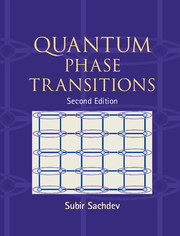Book contents
- Frontmatter
- Contents
- From the Preface to the first edition
- Preface to the second edition
- Part I Introduction
- Part II A first course
- Part III Nonzero temperatures
- Part IV Other models
- 16 Dilute Fermi and Bose gases
- 17 Phase transitions of Dirac fermions
- 18 Fermi liquids, and their phase transitions
- 19 Heisenberg spins: ferromagnets and antiferromagnets
- 20 Spin chains: bosonization
- 21 Magnetic ordering transitions of disordered systems
- 22 Quantum spin glasses
- References
- Index
18 - Fermi liquids, and their phase transitions
from Part IV - Other models
Published online by Cambridge University Press: 16 May 2011
- Frontmatter
- Contents
- From the Preface to the first edition
- Preface to the second edition
- Part I Introduction
- Part II A first course
- Part III Nonzero temperatures
- Part IV Other models
- 16 Dilute Fermi and Bose gases
- 17 Phase transitions of Dirac fermions
- 18 Fermi liquids, and their phase transitions
- 19 Heisenberg spins: ferromagnets and antiferromagnets
- 20 Spin chains: bosonization
- 21 Magnetic ordering transitions of disordered systems
- 22 Quantum spin glasses
- References
- Index
Summary
The Fermi liquid is perhaps the most familiar quantum many-body state of solid state physics; we met it briefly in Section 16.2.2. It is the generic state of fermions at nonzero density, and is found in all metals. Its basic characteristics can already be understood in a simple free fermion picture. Noninteracting fermions occupy the lowest energy single-particle states, consistent with the exclusion principle. This leads to the fundamental concept of the Fermi surface: a surface in momentum space separating the occupied and empty single fermion states. The lowest energy excitations then consist of quasiparticle excitations which are particle-like outside the Fermi surface, and hole-like inside the Fermi surface. Landau's Fermi liquid theory is a careful justification for the stability of this simple picture in the presence of interactions between fermions. Just as we found in Chapters 5 and 7 for the quantum Ising and rotor models, interaction corrections modify the wavefunction of the quasiparticle and so introduce a quasiparticle residue A; however, they do not destabilize the integrity of the quasiparticle, as we review in Section 18.1.
The purpose of this chapter is to describe two paradigms of symmetry breaking quantum transitions in Fermi liquids. In the first class, studied in Section 18.2, the broken symmetry is related to the point-group symmetry of the crystal, while translational symmetry is preserved; consequently, the order parameter resides at zero wavevector. In the second class, studied in Section 18.3, the order parameter is at a finite wavevector, and so translational symmetry is also broken.
- Type
- Chapter
- Information
- Quantum Phase Transitions , pp. 346 - 374Publisher: Cambridge University PressPrint publication year: 2011



